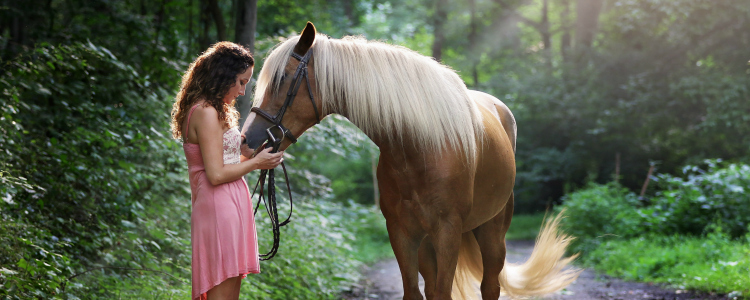Equine-Assisted Therapy and Implications for Treatment of Eating Disorders
Equine-assisted therapy has been an emerging form of psychotherapy in recent decades. While research has demonstrated its efficacy in treating mental health diagnoses such as PTSD, autism, and mood disorders, research regarding equine-assisted therapy and eating disorders is lacking. As a therapist using the Equine-Assisted Growth and Learning Association (EAGALA) model of equine-assisted psychotherapy (EAP), I have been able to observe how aspects of the model and working with horses in general could be beneficial in the treatment of eating disorders.
Equine-assisted therapy has the potential to directly address symptoms that sustain eating disordered behavior and prevent the development of an eating disorder in those that may be vulnerable or subthreshold. Some of the psychological risk factors associated with eating disorders are fear of losing control, pathological body dissatisfaction, and traits of obsessive-compulsive disorder. Those suffering from eating disorders are often known for rigidity in their thinking and behavior, perfectionism, and negative self-image. Equine-assisted therapy, learning, and therapeutic riding models all offer unique therapeutic approaches to develop flexibility, patience, empathy, and confidence.
Horses are prey animals. As a result, the only judgment horses make when meeting novel objects, animals, or people is if that new thing will eat them. Horses are herd animals as a means of protection. This makes them very intuitive and sensitive to any anxiety; if a herd member is experiencing anxiety, it means there may be a predator present. They are unconcerned about pleasing aesthetics; they only care about how a person makes them feel at that moment. One client I worked with, Anna, was obsessively concerned with her outward appearance including her size and weight. In her words, she wanted others around her to know that she “had it all together.” Because we work outside with the horses, every session she was racked with anxiety about the wind messing up her hair style, getting dirt under her fingernails or on her clothes, her make up running because of sweating, etc. For our first couple of sessions, she was given the task of introducing herself to the herd, how that occurs is left to the interpretation by the client. Every time Anna approached a horse, he would walk away; it appeared as they were intuitive to her anxiety about her appearance. One herd member, Little Donkey, is known to blatantly point out issues that clients need to address. Little Donkey would follow Anna around and grab at her clothing or jewelry, lick her hands, arms, or legs, or attempt to scratch his head on her. At the time, Little Donkey was seven years old with an aversion to getting a bath and as a result, he was visibly dirty. She did everything she could to avoid him but he persisted. My third session started as the first two had: the horses avoiding her and Little Donkey pursuing her. After a few moments, I saw Anna take a deep breath and release, turned around, and began scratching Little Donkey’s ears. That was the moment in her therapeutic process that she began to let go of how others’ might perceive her, focusing on her strengths, and embracing imperfection.
Working with horses is often a lesson in flexibility. Clients with eating disorders can be very rigid in their thinking and beliefs; equine-assisted therapy helps clients to let go of that obsessive control. Often if a client attempts to control a horse by force, the horse can become uncooperative and stubborn. Successfully completing therapy tasks requires patients, flexibility, and a relationship with the horse. An equine-assisted therapy task may even lead in a completely different direction than originally intended. I had been working with a client, Beth, for a couple of months on giving up some control and increasing flexibility. She was rigid in thinking that every task she attempted had to be perfectly done. Even putting a halter on a horse had to be done exactly the right way, almost ritualistically. During one session, a horse in another pasture managed to get his head stuck in an 80 lbs. steel gate, rip it off the hinges, and go running around the pasture with the gate around his neck. I had to have Beth let go of the horse she had been working with and assist me in this emergency situation for the safety of the horse. She hesitated and looked visibly anxious at leaving her task unfinished but after emphasizing the urgency of the situation, she followed me into the other pasture. Despite her anxiety, we were able to calm the horse down, get his head unstuck from the gate, and make sure he was physically healthy. In equine-assisted therapy, tasks and occurrences with the horses are all used as metaphors in relation to the client’s life. While we processed the session, Beth felt that the steel gate was a metaphor for her rigid eating disordered thoughts and how dangerous they had become for her. She also described needing help getting that steel gate off her neck in order to continue her life safely and successfully.
Anna and Beth are two examples of how equine-assisted therapy can be beneficial in the treatment of eating disorders. Eating disorders are difficult to treat and there are few counseling approaches shown to be effective. Equine assisted therapy is relatively new, and research is still emerging. This type of therapy has the potential to increase flexibility, confidence, and self-awareness, as well as provide clients with a unique relationship with another being. It also has the potential to be combined with other counseling approaches such as cognitive behavioral therapy, dialectical behavioral therapy, family therapy, etc. to maximize effectiveness of treatment. I have had the privilege to witness the benefits of equine-assisted psychotherapy and I look forward to continuing to explore its benefits.
Kristen Rose, M.Ed., NCC, LPC earned her bachelor’s degree in psychology from Hasting College in Hastings, Nebraska, and a master’s degree in counseling from the University of North Carolina at Pembroke. Her eclectic professional background includes experience with equine-assisted psychotherapy, art therapy, and traditional office therapy. Experienced in working with children, adolescents, and adults, she specializes in treating eating disorders and substance abuse as well as other mental and behavioral issues. She is currently a therapist in Outpatient Behavioral Services at First Health of the Carolinas in Pinehurst, North Carolina.





